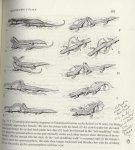A Natural History of Amphibians by Robert C. Stebbins and Nathan W. Cohen (Princeton, NJ: Princeton Univ. Press, 1995) 316 pp.
So now you’ve read a basic book or two (say, Indiviglio’s, or Bartlett’s Dummies) and perhaps you even have an Audubon or Peterson’s Guide. But you want to know more about what makes our slimy friends tick. I’ve scared you off Duellman and Trueb, so, what to seek? Where to turn? Spin no longer. The sun has come out; string up your hammock and crack this book open.
As the authors state in their preface, this book covers amphibians, “their taxonomic relationships, how and where they live and reproduce, how they interact with one another and their environment, and the evolutionary processes that have made them what they are and that continue to shape their future.” (p. xii-xiii)
Once you have basic care down and want to move on, here you’ll learn things such as that in many natural areas, “amphibians may exceed in numbers and bulk per acre each of the other classes of terrestrial vertebrates—the reptiles, birds, and mammals." (4) And, “n many habitats amphibians are a major ‘conveyor belt’ that provides for transfer of invertebrate energy sources to predatory animals higher up the food chain—to the many species of reptiles (particularly snakes)…”, a process called “biomass conversion.” (5) And you thought they just hid under rocks.
Do you want to know why some salamanders have flat eyes, and why some have bug-eyes? Do salamanders have teeth? Do they have vocal chords? Why do frogs croak? How do amphibians stay warm if they’re cold-blooded, and how warm do they need to be? How do they survive the winter?
Why are salamanders slimy? How do they stay slimy? Is it true that salamanders are toxic? What is the most poisonous part of a salamander? How do salamanders breathe? Is it true that some of them DON’T EVEN HAVE LUNGS? What is that pumping thing they do with their throat?
You will learn whether amphibians are oviparous, viviparous, ovoviviparous, and whether that’s similar to being vegetarian, a lactovegetarian, or an ovo-lacto vegetarian.
When do amphibians mate? How do amphibians mate (and there is more variety in breeding patterns of amphibians than in all of the Kama Sutra)? How do salamanders find their way back to their natal ponds? How can you tell boy amphibians from girl amphibians? What’s up with this “amplexus” stuff? How long after they mate do they lay eggs? Why are some amphibian eggs big and why are some small? What is “intrauterine cannibalism” (it’s not just for Rosemary’s Baby anymore!)? Do amphibians help raise their young? How can you tell a tadpole (frog baby) from a larva (salamander baby)?
You will also learn that frogs are much more biologically complex and evolutionarily advanced than salamanders. Maybe this is why I find frog science so creepy and threatening, since I can barely wrap my head around the biology of salamanders. That whole metamorphosis thing just freaks me out.
Do you want to know why salamanders are colored the way they are?
How do they hunt and find prey? How do they fend off predators? How big are salamander territories? Why does neoteny occur? Why are amphibians declining, and do we need amphibians? Why should we even care?
Now THIS book was more my speed. I understood every sentence in this book. If I had to look up a word in the dictionary, it was there.
If you are curious about the answers to the questions above, this book will be YOUR speed, too. I hardly had to make any sarcastic comments in the margins anywhere, except for one side comment comparing the courtship of frogs to that of Klingons.
The book contains many informative drawings as well as a number of black & white photos. I scanned in three of the drawings. so that you can see how nice they are. The first is a sequence of a salamander shedding its skin (with moves as sensuous and undulating as any stripper’s); the second, of an Ensatina mating dance; and the third is the cutest little drawing of a newt I’ve ever seen. If I ever get a newt tattoo, that’ll be it.
Once you have absorbed the information in this book, the amazing world of amphibians will begin to make sense. The best reviewer quote on the back cover states, “an excellent, informative book full of wonders and delights.”
The bibliography is 48 pages long, and the index, 15 pages.
Available used on amazon starting at $16.50. Prices seem to be up these days; I don’t think I paid that much for my copy. If that’s too much (and the book is definitely worth it), wait a while, or look on alibris or elsewhere.
So now you’ve read a basic book or two (say, Indiviglio’s, or Bartlett’s Dummies) and perhaps you even have an Audubon or Peterson’s Guide. But you want to know more about what makes our slimy friends tick. I’ve scared you off Duellman and Trueb, so, what to seek? Where to turn? Spin no longer. The sun has come out; string up your hammock and crack this book open.
As the authors state in their preface, this book covers amphibians, “their taxonomic relationships, how and where they live and reproduce, how they interact with one another and their environment, and the evolutionary processes that have made them what they are and that continue to shape their future.” (p. xii-xiii)
Once you have basic care down and want to move on, here you’ll learn things such as that in many natural areas, “amphibians may exceed in numbers and bulk per acre each of the other classes of terrestrial vertebrates—the reptiles, birds, and mammals." (4) And, “n many habitats amphibians are a major ‘conveyor belt’ that provides for transfer of invertebrate energy sources to predatory animals higher up the food chain—to the many species of reptiles (particularly snakes)…”, a process called “biomass conversion.” (5) And you thought they just hid under rocks.
Do you want to know why some salamanders have flat eyes, and why some have bug-eyes? Do salamanders have teeth? Do they have vocal chords? Why do frogs croak? How do amphibians stay warm if they’re cold-blooded, and how warm do they need to be? How do they survive the winter?
Why are salamanders slimy? How do they stay slimy? Is it true that salamanders are toxic? What is the most poisonous part of a salamander? How do salamanders breathe? Is it true that some of them DON’T EVEN HAVE LUNGS? What is that pumping thing they do with their throat?
You will learn whether amphibians are oviparous, viviparous, ovoviviparous, and whether that’s similar to being vegetarian, a lactovegetarian, or an ovo-lacto vegetarian.
When do amphibians mate? How do amphibians mate (and there is more variety in breeding patterns of amphibians than in all of the Kama Sutra)? How do salamanders find their way back to their natal ponds? How can you tell boy amphibians from girl amphibians? What’s up with this “amplexus” stuff? How long after they mate do they lay eggs? Why are some amphibian eggs big and why are some small? What is “intrauterine cannibalism” (it’s not just for Rosemary’s Baby anymore!)? Do amphibians help raise their young? How can you tell a tadpole (frog baby) from a larva (salamander baby)?
You will also learn that frogs are much more biologically complex and evolutionarily advanced than salamanders. Maybe this is why I find frog science so creepy and threatening, since I can barely wrap my head around the biology of salamanders. That whole metamorphosis thing just freaks me out.
Do you want to know why salamanders are colored the way they are?
How do they hunt and find prey? How do they fend off predators? How big are salamander territories? Why does neoteny occur? Why are amphibians declining, and do we need amphibians? Why should we even care?
Now THIS book was more my speed. I understood every sentence in this book. If I had to look up a word in the dictionary, it was there.
If you are curious about the answers to the questions above, this book will be YOUR speed, too. I hardly had to make any sarcastic comments in the margins anywhere, except for one side comment comparing the courtship of frogs to that of Klingons.
The book contains many informative drawings as well as a number of black & white photos. I scanned in three of the drawings. so that you can see how nice they are. The first is a sequence of a salamander shedding its skin (with moves as sensuous and undulating as any stripper’s); the second, of an Ensatina mating dance; and the third is the cutest little drawing of a newt I’ve ever seen. If I ever get a newt tattoo, that’ll be it.
Once you have absorbed the information in this book, the amazing world of amphibians will begin to make sense. The best reviewer quote on the back cover states, “an excellent, informative book full of wonders and delights.”
The bibliography is 48 pages long, and the index, 15 pages.
Available used on amazon starting at $16.50. Prices seem to be up these days; I don’t think I paid that much for my copy. If that’s too much (and the book is definitely worth it), wait a while, or look on alibris or elsewhere.
Attachments
Last edited:




